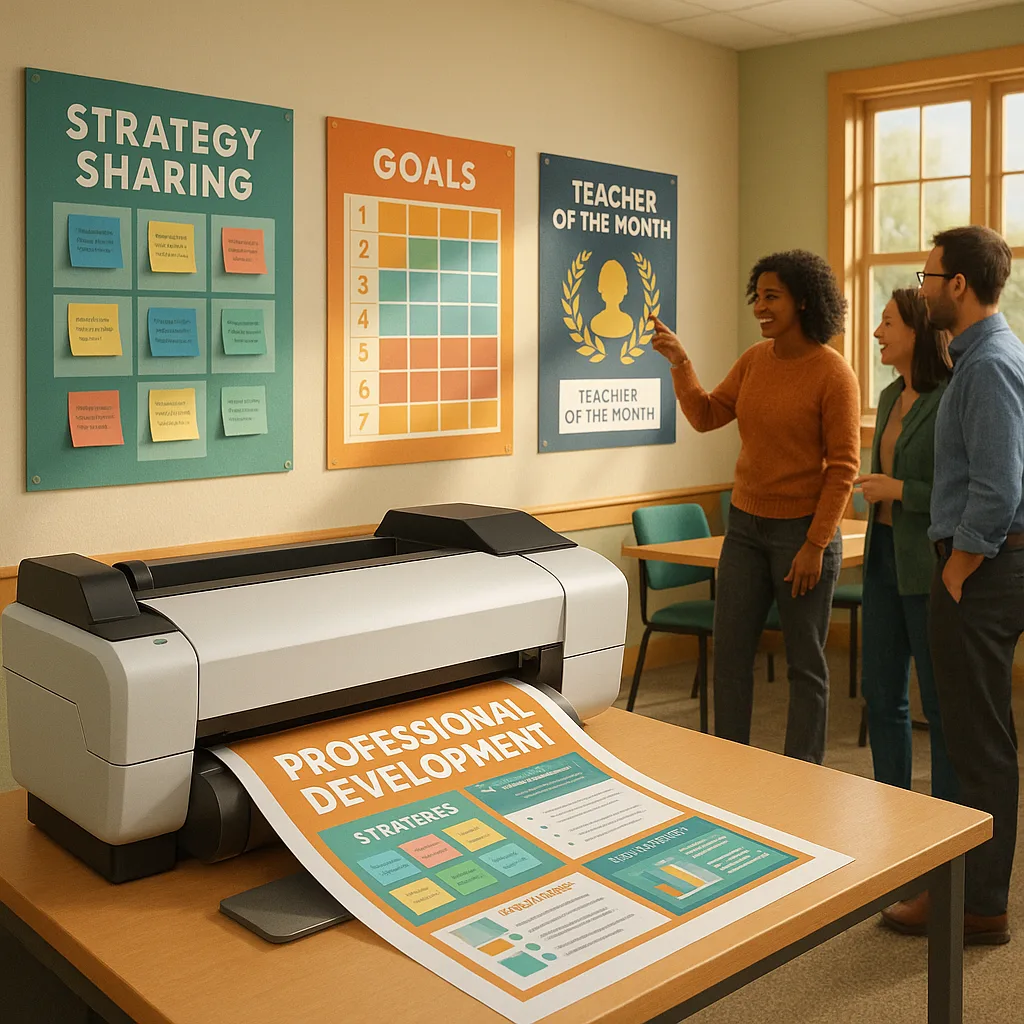Poster Machine for Schools Builds Teacher Confidence
The Power of Visual Professional Development
Professional development transforms when it becomes visible, tangible, and celebrated. Furthermore, research shows that teachers who engage with visual learning materials retain 65% more information compared to text-only formats. Therefore, incorporating a poster print machine into your professional development strategy creates lasting impact.
Visual displays serve multiple psychological purposes in teacher development. First, they externalize abstract concepts, making complex pedagogical strategies accessible. Second, they create environmental cues that reinforce learning long after workshops end. Finally, they build community by making individual growth visible to the collective.
Reflection prompt: How might your professional development sessions change if participants could immediately create and display their learning?
Creating Strategy-Sharing Displays
Successful teaching strategies shouldn’t remain isolated in individual classrooms. Instead, create visual galleries where educators share their most effective techniques. Subsequently, these displays become living libraries of pedagogical wisdom that grow throughout the school year.
Consider developing rotating displays featuring “Strategy of the Month” posters. Additionally, invite teachers to contribute their favorite classroom management techniques, differentiation strategies, or engagement activities. Then, use your poster machine for schools to create consistent, professional-looking displays that honor each contribution equally.

Professional development made visible with quality printing
Design these strategy posters with clear sections: the challenge addressed, the strategy itself, implementation steps, and evidence of success. Furthermore, include QR codes linking to video demonstrations or additional resources. As a result, colleagues can easily adopt and adapt strategies that resonate with their teaching style.
of teachers report increased confidence when their strategies are visually recognized
Building Collaborative Learning Communities
Professional development thrives in communities where learning is shared, celebrated, and continuously evolving. Furthermore, visual displays create the foundation for these collaborative environments.
Peer Observations
Create visual schedules for peer observationsImplementation Guide
Design observation calendars with your poster print machine. Include observation focus areas, reflection prompts, and space for feedback notes. Display in staff areas to normalize peer learning.Book Studies
Transform reading into visual learningVisual Summaries
Create chapter summary posters during professional book studies. Each participant contributes visual notes, creating a gallery of collective insights that remain accessible year-round.Celebration Walls
Highlight achievements visuallyRecognition Systems
Design monthly celebration posters featuring teacher achievements, innovative lessons, and student success stories. Regular recognition builds confidence and encourages continued growth.Implementation Strategies for Success
Launching a visual professional development program requires thoughtful planning and consistent execution. First, establish a dedicated space for professional development displays—perhaps a staff lounge wall or corridor near teacher workrooms. Subsequently, create a rotating schedule ensuring all educators have opportunities to contribute.
Begin with voluntary participation to build enthusiasm. Additionally, provide design support through templates and brief training sessions on using the poster machine for schools. Then, celebrate early adopters publicly to encourage broader participation.
Consider forming a Professional Development Visual Committee. Furthermore, this group can curate displays, organize poster creation workshops, and ensure content remains fresh and relevant. As a result, ownership becomes distributed, and the program sustains itself organically.
Monthly themes provide structure while allowing creativity:
• September: Classroom Management Strategies
• October: Technology Integration Tips
• November: Gratitude and Recognition
• December: Reflection and Goal Setting
• January: New Year, New Strategies
• February: Collaborative Teaching Methods
• March: Assessment Innovations
• April: Spring into Student Engagement
• May: Year-End Celebrations


